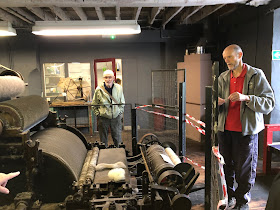May brought for me a fiber tour of Cornwall; on our way there my tour group stopped in Devon. We visited Cold Harbour Mill which is a working museum in Uffculme, on the River Culm. Cold Harbour is one of the "oldest working mills in the UK having been in continuous production since 1797" according to their website. It was a two and a half hour ride west from London just off the M5.
We had a lovely lunch before the tour. I did not have ONE BAD MEAL in England. I think that the bad food reputation is due to the privations during and after WWII . Here is the pub scene at noon on a Sunday. My lunch was excellent.
Then on to the mill. It is in a lovely setting and is well maintained.
I try to listen closely to a tour guide when touring mills but I still don't understand what exactly all the machines do. But I think they are all very ingenious and beautiful.
Puttees were made in this factory... the company had a steaming process that helped puttees mold to the legs. I was surprised at the number of countries in which they were worn. But then of course, the British empire and the influence on current and past holdings was immense, and I suppose that the puttees were a practical way to dress in many unfriendly environments.

This was the air raid room for use during WWII
I always think of the poor people, often children, who were probably considered lucky to have jobs in these places, spinning cotton and wool into threads with little or no safety concern.
I found the BBC program "The Mill" on Amazon prime, which has given life to this setting for me. The irony that the mill owner's wife was "antislavery" and yet the child workers were beholden to work in the mills is the ironic touch.
We had a lovely lunch before the tour. I did not have ONE BAD MEAL in England. I think that the bad food reputation is due to the privations during and after WWII . Here is the pub scene at noon on a Sunday. My lunch was excellent.
Then on to the mill. It is in a lovely setting and is well maintained.
I try to listen closely to a tour guide when touring mills but I still don't understand what exactly all the machines do. But I think they are all very ingenious and beautiful.
Puttees were made in this factory... the company had a steaming process that helped puttees mold to the legs. I was surprised at the number of countries in which they were worn. But then of course, the British empire and the influence on current and past holdings was immense, and I suppose that the puttees were a practical way to dress in many unfriendly environments.

This was the air raid room for use during WWII
I always think of the poor people, often children, who were probably considered lucky to have jobs in these places, spinning cotton and wool into threads with little or no safety concern.
I found the BBC program "The Mill" on Amazon prime, which has given life to this setting for me. The irony that the mill owner's wife was "antislavery" and yet the child workers were beholden to work in the mills is the ironic touch.


















No comments:
Post a Comment